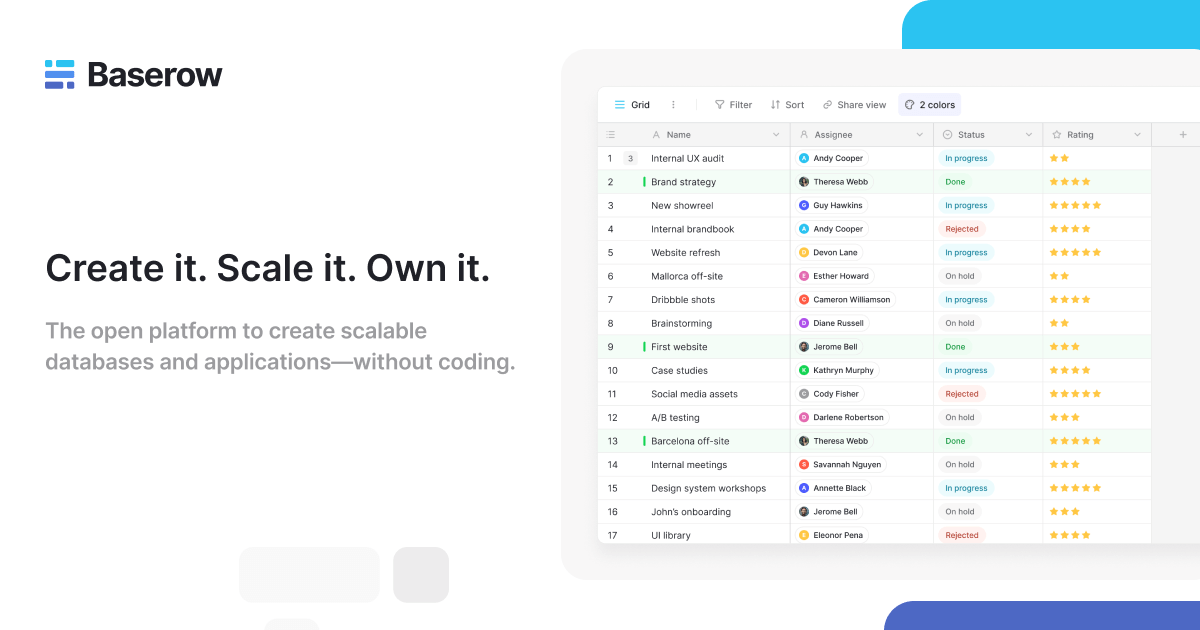Overview
Discover what makes Baserow powerful
Baserow is a **self‑hosted, open‑source relational database platform** that lets developers treat data as first‑class citizens. At its core, it exposes a *table‑based* schema—akin to spreadsheets but with full SQL semantics—while providing a rich API layer for programmatic access. The application is built to be **API‑centric**: every CRUD operation, schema change, or workflow trigger can be invoked via REST/GraphQL endpoints, making it a natural fit for micro‑service ecosystems or data pipelines that require tight integration with external systems.
Multi‑view UI
Workflow engine
AI‑first hooks
Permission model
Overview
Baserow is a self‑hosted, open‑source relational database platform that lets developers treat data as first‑class citizens. At its core, it exposes a table‑based schema—akin to spreadsheets but with full SQL semantics—while providing a rich API layer for programmatic access. The application is built to be API‑centric: every CRUD operation, schema change, or workflow trigger can be invoked via REST/GraphQL endpoints, making it a natural fit for micro‑service ecosystems or data pipelines that require tight integration with external systems.
Key Features
- Multi‑view UI: Grid, Kanban, Calendar, Timeline, Form and Survey views allow rapid prototyping of front‑end interfaces without writing HTML/JS. These views are rendered server‑side and can be embedded or served as standalone pages.
- Workflow engine: A low‑code automation builder exposes HTTP, email, webhooks and third‑party connectors. Developers can chain events (e.g., “when a row is inserted, send an email and create a task in another system”) without leaving the platform.
- AI‑first hooks: Experimental AI fields and agents let you plug in custom inference services or auto‑complete logic, all exposed via standard API calls.
- Permission model: Row‑level and field‑level access controls are configurable through the UI or programmatically via the API, enabling fine‑grained security for multi‑tenant deployments.
Technical Stack
| Layer | Technology |
|---|---|
| Backend | Python 3.11, Django REST Framework, Channels (WebSocket support) |
| Database | PostgreSQL 15+ (primary), optional SQLite for lightweight dev installs |
| Search & Indexing | ElasticSearch 8.x (optional) or PostgreSQL full‑text search |
| Containerization | Docker Compose, Helm charts for Kubernetes |
| CI/CD | GitHub Actions (open‑source repo) |
| Optional AI Layer | Custom MCP server, open‑source LLM models (e.g., GPT‑4‑like) |
The architecture follows a micro‑service style: the core Django app handles authentication, schema management, and API routing; separate worker containers (Celery) process background jobs such as workflow triggers and AI inference. The UI is a lightweight React SPA served by Django’s templating engine, reducing client‑side complexity.
Core Capabilities
- REST & GraphQL APIs: Full CRUD, schema migration, and workflow execution. Pagination, filtering, and aggregation are supported out of the box.
- Webhooks: Outbound hooks for external services; inbound webhooks can trigger workflow actions.
- Schema API: Programmatic creation of tables, fields, and relations; supports foreign keys, many‑to‑many links, and lookup calculations.
- Export/Import: CSV, JSON, XML; importers can be extended via plugin modules.
Deployment & Infrastructure
Baserow is designed for on‑premises or cloud deployments. The Docker image includes all dependencies, and a Helm chart simplifies Kubernetes rollout:
- Scalability: Horizontal scaling is achieved by replicating the Django workers and using a shared PostgreSQL cluster. The UI can be load‑balanced via Ingress.
- High Availability: PostgreSQL replication, persistent volumes for Docker Swarm, and stateful sets in Kubernetes ensure zero downtime.
- Observability: Prometheus metrics, Grafana dashboards, and structured logging are integrated; developers can expose custom metrics through the API.
Integration & Extensibility
- Plugin System: Developers can write Python packages that hook into Baserow’s signals (e.g.,
post_row_create) and expose new API endpoints or UI components. - Custom Connectors: The workflow builder’s connector registry can be extended with new HTTP adapters, SDKs, or GraphQL clients.
- Embedding: The platform can be embedded into existing applications via iframe or as a micro‑frontend served by the same domain, leveraging CORS and session tokens.
Developer Experience
The documentation is API‑first: Swagger/OpenAPI specs are auto‑generated and kept in sync with the codebase. A comprehensive developer guide covers authentication, pagination, bulk operations, and custom field types. Community support is active on GitHub Discussions, Discord, and a dedicated Slack channel. The open‑source license (MIT) removes vendor lock‑in, allowing developers to modify the core code for compliance or performance tuning.
Use Cases
- Internal SaaS Platforms – Rapidly build CRUD‑heavy backends for internal tools (CRM, asset management) without writing a database layer.
- Data Lakefront – Ingest CSV/JSON from legacy systems, expose a unified API for downstream analytics services.
- Compliance‑Heavy Environments – Leverage row‑level permissions and self‑hosting to satisfy GDPR, HIPAA, or SOC2 requirements.
- Workflow Automation – Replace manual Excel‑based processes with automated triggers that integrate with Jira, Slack, or custom micro‑services.
Advantages
- Performance & Flexibility: PostgreSQL’s ACID guarantees combined with Django’s ORM provide robust transaction support; developers can still write raw SQL when needed.
- Zero Vendor Lock‑In: Full source control, MIT license, and Docker/Helm support allow migration to any cloud provider or on‑prem hardware.
- Rapid Prototyping: The visual UI and low‑code workflow builder reduce time to market,
Open SourceReady to get started?
Join the community and start self-hosting Baserow today
Related Apps in databases
NocoDB
Build databases like spreadsheets, no code required
ChartDB
Instant database diagramming and migration without passwords
Bytebase
Database CI/CD for DevOps teams
Datasette
Explore and publish data as interactive websites
Adminer
Single‑file database manager in PHP
Evidence
Generate BI reports from SQL and markdown
Weekly Views
Repository Health
Information
Tags
Explore More Apps
RERO ILS
Modern open‑source library management for heritage, public and school libraries
Seerr
Self-hosted media request manager for Jellyfin, Plex, and Emby
TeslaMate
Self-hosted Tesla data logger and analytics
Zero-K
Free, physics‑based RTS with vast units and maps
BookBounty
Find missing Readarr books via Library Genesis
Tailchat
Next‑generation IM platform with built‑in plugin ecosystem
